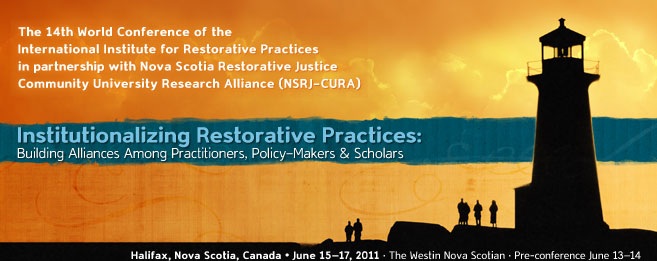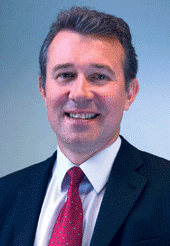News & Announcements
- Details
- Written by Joshua Wachtel
 Two comments on the IIRP's 14th International Conference in Halifax, Nova Scotia:
Two comments on the IIRP's 14th International Conference in Halifax, Nova Scotia:
One thing I learned is that Restorative Practices advocates are increasingly seeing themselves as part of a broad social movement to build community and hold people accountable using the power of relationships instead of relying on impersonal coercion and punishment.
-- John Bailie, IIRP Director of Continuing Ed
[quote]The Halifax IIRP conference was my 14th such conference and without a doubt was the most impressive I have experienced. The quality of the 100 or so workshops was outstanding. The first day plenary sessions were riveting with a range of impressive presenters. Congratulations to Jennifer Llewellyn [NSRJ- CURA] and Ted & Susan Wachtel [IIRP] for your visionary leadership.[/quote]
-- Terry O'Connell, Director of IIRP Australia
- Details
- Written by Janet Briggs
This article by the manager of the Nova Scotia Restorative Justice Program gives a history of the program from its start in 1977 as well as major program components and goals.
- Details
- Written by Jennifer Llewellyn
The director of the Nova Scotia Restorative Justice Community University Research Alliance (NSRJ-CURA), which cosponsored the June 2011 IIRP World Conference, welcomes conference attendees and explains the history and focus of NSRJ-CURA.
- Details
- Written by Joshua Wachtel
On March 15, 2011, the Netherlands Parliament voted unanimously to amend the Child Protection Act. The Act now grants parents or guardians of a child the right to meet with family and other involved friends or close family supporters to make their own plan regarding how to care for a child of concern. The right to meet and make a plan for a child comes as a first recourse before the state and courts are permitted to intervene.
Rob van Pagée, director of Eigen Kracht Centrale, a nonprofit organization that led lobbying efforts for the law said, “We see this as a validation for the rights of citizens.”
Eigen Kracht Centrale’s family group conference (FGC) model is based on the New Zealand model, which was encoded in law as a first resort for Maori and Pakeha children in 1989. Eigen Kracht, meaning “our strength” or “our power,” introduced family group conferencing to the Netherlands in 2001 and has since trained over 500 paid part-time coordinators who have run over 4000 Eigen Kracht conferences. Family group conferencing (FGC) is known as family group decision making (FGDM) in the US.
- Details
- Written by Laura Mirsky
"I used to be really loud because I was talking over the kids in my classroom. I would yell and be sarcastic. The students’ response was, ‘You’re gonna yell at me? We yell all the time at my house.’ In my classroom now, because of restorative practices, we’re all quieter than we used to be and listening is deeper. And classes are more relaxing and less tiring than they used to be for me." —Erin Dunlevy, Spanish and drama teacher, High School for Arts, Imagination and Inquiry, New York City
Teachers in 22 schools across the US are having experiences like Erin Dunlevy’s, due to the IIRP’s two-year Whole-School Change Program. An explicit road map for training entire school staffs, the program also includes built-in systems for monitoring, measuring and sustaining implementation. The complete program is spelled out in the Restorative Practices Whole-School Implementation Overview, at: www.iirp.edu/pdf/SSS_Implementation_Overview.pdf.
“We have been working on training in restorative practices for public education for many years,” said IIRP director of continuing education John Bailie. “The most current evolution is not just about teaching the skills of restorative practices but effecting lasting, sustainable organizational change. Schools are large, complex organizations that aren’t easy to change.”
- Details
- Written by Thomas S. Fertal
Tom Fertal is principal of Lancaster Catholic High School, in Lancaster, Pennsylvania, USA. He is also a Master of Restorative Practices and Education candidate at the International Institute for Restorative Practices (IIRP) Graduate School, in Bethlehem, Pennsylvania.
In the summer of 2008 I enrolled in my first restorative practices courses at the International Institute for Restorative Practices Graduate School in Bethlehem. I had just been named vice principal of student affairs at my high school. My major responsibility was student discipline.
As an administrator at a private, faith-based school, I had never been satisfied with the traditional system of detentions, suspensions and “Saturday school” in use at our school. I had long known that we needed an alternative to those traditional methods, but I hadn’t known what they might be.
I had heard the term “restorative justice,” but at the time I hadn’t known much about it. A quick search on the internet had led me to the IIRP in Bethlehem, my old hometown, a mere 70 miles from my school!
- Details
- Written by Laura Mirsky
In Restorative Collaboration: The Nova Scotia Restorative Justice Program (iirp.edu/news/restorative-collaboration-the-nova-scotia-restorative-justice-program), Jennifer Llewellyn, professor of law at Halifax’s Dalhousie University and director of the Nova Scotia Restorative Justice Community University Research Alliance (NSRJ-CURA), described the foundations of the province’s restorative justice program. (The paper was delivered at the 2009 IIRP World Conference, in Bethlehem, Pennsylvania, USA.) This article focuses on how the restorative approach is being implemented in school and community settings within the province.
In its twelfth year, Restorative Justice Nova Scotia (NSRJ) shows promising results in schools and communities, through a vibrant partnership between government and the community.
“Traditionally,” said Llewellyn, “Government strategies carve kids up instead of treating them in an integrated way, but kids come in one body. They need an integrated response. Government ‘silos’ result in cracks for them to fall through. We asked, ‘Why don’t we start looking at the children and their integrated reality?’ This allows us to think in more collaborative ways.”
- Details
- Written by Joshua Wachtel
“At first I didn’t comprehend what had happened.” Jordan Humble, a student and resident advisor (RA) at the University of Vermont (UVM), left his lab on October 18, 2010, around 7:30 p.m. and learned from text and voice messages that something terrible had happened on his residence hall floor. He made his way home to discover that a student had been found dead on his floor and that police and emergency personnel were already on-site. Only students directly involved in finding the young man’s body were allowed to remain in the building. Humble joined them while they waited to be interviewed by a detective.
“I wanted to get a feel of where everyone was at emotionally," said Humble. “I asked them what they had been talking about and what steps they had gone through. It became a coping session until I could tell people had had enough of it. Then I directed it to a more free-flowing atmosphere. I brought in games, we made paper airplanes, to get their minds off what had been going on.”
- Details
- Written by IIRP
View the conference schedule and presentation materials (where provided).
- Details
- Written by IIRP
 Nigel RichardsonIn Hull we are working towards becoming the world’s first restorative city. We know this is a bold ambition and the challenges ahead are significant, but we believe this is the best and most effective way of working together with children, families, schools and communities. Like many other communities who are using restorative practices (RP) we have learnt a great a deal and are witnessing some outstanding results. We have also experienced many struggles and challenges and still have a long way to go. To help us we have received some first-class support and guidance from the IIRP and from other friends and colleagues from around the world.
Nigel RichardsonIn Hull we are working towards becoming the world’s first restorative city. We know this is a bold ambition and the challenges ahead are significant, but we believe this is the best and most effective way of working together with children, families, schools and communities. Like many other communities who are using restorative practices (RP) we have learnt a great a deal and are witnessing some outstanding results. We have also experienced many struggles and challenges and still have a long way to go. To help us we have received some first-class support and guidance from the IIRP and from other friends and colleagues from around the world.
Hull is home to 57,000 children and young people growing up in a multicultural, densely populated and fast-changing urban area. The city has high levels of unemployment, crime, poverty and need. Consequently, statutory, voluntary and private organisations in the city have committed themselves to doing something different to improve the lives of children and young people here. We are using restorative practices as a shared way of working to ensure everyone uses the same ethos, delivering services in an open, respectful and mutually accountable way set within a restorative framework. This framework requires us to work with children, families and the community and provides the ‘glue’ that binds together agencies in a common approach and language.

Restorative Works Year in Review 2023 (PDF)
All our donors are acknowledged annually in Restorative Works.
